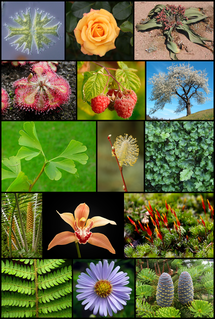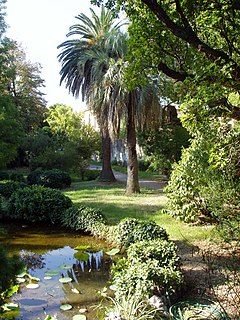
A botanical garden or botanic garden is a garden dedicated to the collection, cultivation, preservation and display of a wide range of plants labelled with their botanical names. It may contain specialist plant collections such as cacti and other succulent plants, herb gardens, plants from particular parts of the world, and so on; there may be greenhouses, shadehouses, again with special collections such as tropical plants, alpine plants, or other exotic plants. Visitor services at a botanical garden might include tours, educational displays, art exhibitions, book rooms, open-air theatrical and musical performances, and other entertainment.

Pinus tabuliformis, also called Manchurian red pine, Southern Chinese pine or Chinese red pine, is a pine native to northern China from Liaoning west to Inner Mongolia and Gansu, and south to Shandong, Henan and Shaanxi, and also northern Korea. In some older texts the name is spelled "Pinus tabulaeformis".
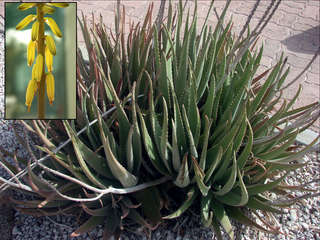
Aloe vera is a succulent plant species of the genus Aloe. An evergreen perennial, it originates from the Arabian Peninsula but grows wild in tropical climates around the world and is cultivated for agricultural and medicinal uses. The species is also used for decorative purposes and grows successfully indoors as a potted plant.

Agumbe is a small village located in Shimoga district, Thirthahalli taluk in the Malnad region of Karnataka, India. It is sometimes called "The Cherrapunji of the South" after Cherrapunji, in Northeast India. Agumbe is associated with rainforest conservation efforts, documentation of medicinal plants, tourism, and the promotion of cottage industry.

Pin Valley National Park is a National park of India located within the Lahaul and Spiti district, in the state of Himachal Pradesh, in far Northern India.

The flora of India is one of the richest in the world due to the wide range of climate, topology and habitat in the country. There are estimated to be over 18,000 species of flowering plants in India, which constitute some 6-7 percent of the total plant species in the world. India is home to more than 50,000 species of plants, including a variety of endemics. The use of plants as a source of medicines has been an integral part of life in India from the earliest times. There are more than 3000 Indian plant species officially documented as possessing into eight main floristic regions : Western Himalayas, Eastern Himalayas, Assam, Indus plain, Ganges plain, the Deccan, Malabar and the Andaman Islands.
The Meghalaya subtropical forests is a montane subtropical moist broadleaf forest ecoregion of eastern India. The ecoregion covers an area of 41,700 square kilometers (16,100 sq mi), encompassing the Khasi Hills, Garo Hills, and Jaintia Hills of India's Meghalaya state, and adjacent portions of Assam state. The ecoregion is one of the most species-rich in India with a rich diversity of birds, mammals, and plants.

Lagerstroemia speciosa is a species of Lagerstroemia native to tropical southern Asia.
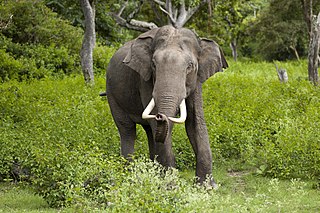
The Indian elephant is one of three recognized subspecies of the Asian elephant and native to mainland Asia.

"Jawaharlal Nehru Tropical Botanic Garden and Research Institute", renamed in the fond memory of visionary Prime Minister of India Shri Pandit Jawaharlal Nehru is an autonomous Institute established by the Government of Kerala on 17 November 1979 at Thiruvananthapuram, the capital city of Kerala. It functions under the umbrella of the Kerala State Council for Science, Technology and Environment (KSCSTE), Government of Kerala. The Royal Botanic Gardens (RBG), Kew played an exemplary and significant role in shaping and designing the lay out of the JNTBGRI garden in its formative stages.
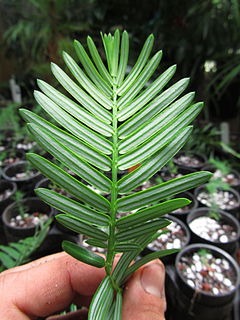
Cephalotaxus mannii is a species of plum-yew. It is a tree up to about 20 metres (66 ft) tall, native to southern China, northeast India, Laos, northern Thailand, northern Myanmar and northern Vietnam. While the species is widespread, its populations are fragmented and it is threatened by cutting for timber as well as for using its bark and leaves for medicinal extracts.

The Grizzled Squirrel Wildlife Sanctuary (GSWS), also known as Srivilliputhur Wildlife Sanctuary, was established in 1988 to protect the vulnerable grizzled giant squirrel. Occupying an area of 485.2 km2, it is bordered on the southwest by the Periyar Tiger Reserve and is one of the best preserved forests south of the Palghat Gap.

The flora of Romania comprises around 3,450 species of vascular plants, which represents around 30% of the vascular flora of Europe.
TRAFFIC, the Wildlife Trade Monitoring Network, is the leading non-governmental organisation working globally on the trade of wild animals and plants in the context of both biodiversity and sustainable development. It was founded in 1976 as a strategic alliance of the World Wide Fund for Nature (WWF) and the International Union for the Conservation of Nature (IUCN).
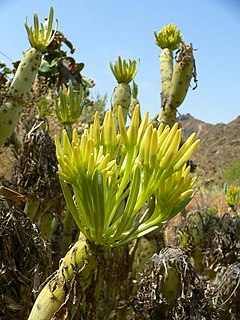
Kleinia is a genus of African flowering plants in the sunflower family. Kleinia contains around 50 species and is distributed from the Canary Islands, throughout Tropical Africa to India and Arabia. It is closely related to the genus Senecio but is distinguished primarily by having succulent stems and/or leaves.
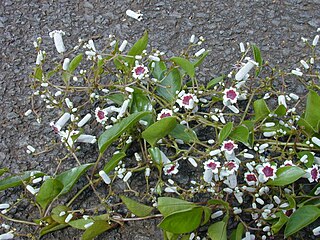
Paederia foetida is a species of plant, with common names that are variations of skunkvine, stinkvine, or Chinese fever vine. It is native to temperate, and tropical Asia; and has become naturalized in the Mascarenes, Melanesia, Polynesia, and the Hawaiian Islands, also found in North America by recent studies.
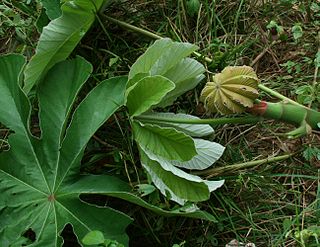
Cecropia peltata is a fast-growing tree in the genus Cecropia. Common names include trumpet tree and snakewood. It is listed as one of the world's 100 worst invasive alien species.

The Stellenbosch University Botanical Garden located in the historical center of Stellenbosch is the oldest university botanical garden in South Africa. The Garden is relatively small and houses an enormous diversity of plants, both indigenous to South Africa and introduced species. It is open to the public.

Arya Vaidya Sala, popularly known as Kottakkal Arya Vaidya Sala, is a healthcare centre located in Kottakkal, in the Indian state of Kerala, known for its heritage and expertise in the Indian traditional medicine system of Ayurveda.

Kotgarh Wildlife Sanctuary is situated in the Baliguda subdivision of Kandhamal district of Odisha state in India. It is classified as an Eastern Highlands moist deciduous forest. Around 52 tribal villages such as Kutia Kondh and Desia Kondh inhabit the sanctuary.
